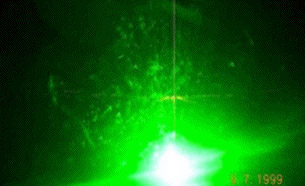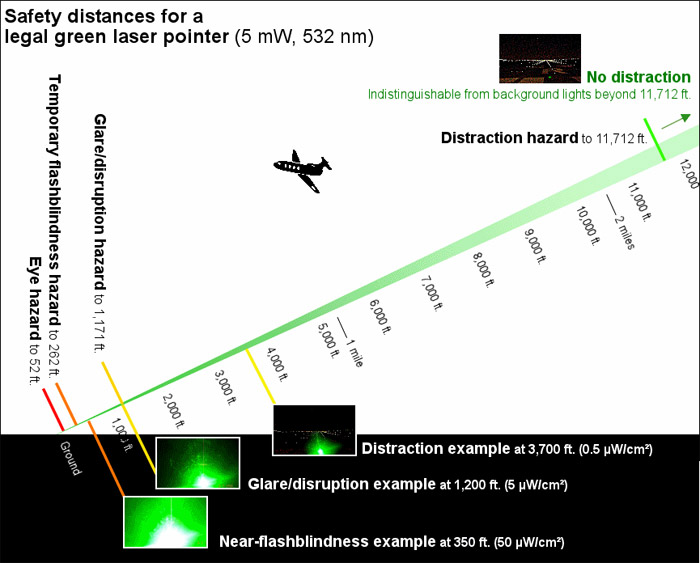Dangerous laser pointer attacks on airplanes may be more common than you think. The FAA today published a list of laser pointer events on aircraft that have been reported in 2010. The list, that only includes incidents within the US, records the huge number of more than 2800 events only last year! This is the highest number of laser events recorded since the FAA began keeping track in 2005.
Los Angeles International Airport recorded the highest number of laser events in the US for an individual airport in 2010, with 102 reports, and the greater Los Angeles area tallied nearly twice that number, with 201 reports. Chicago O’Hare International Airport was a close second, with 98 reports, and Phoenix Sky Harbor International Airport and Norman Y. Mineta San Jose International Airport tied for the third highest number of laser events for the year with 80 each.
 “This is a serious safety issue,†said U.S. Transportation Secretary Ray LaHood. “Lasers can distract and harm pilots who are working to get passengers safely to their destinations.â€
“This is a serious safety issue,†said U.S. Transportation Secretary Ray LaHood. “Lasers can distract and harm pilots who are working to get passengers safely to their destinations.â€
Nationwide, laser event reports have steadily increased since the FAA created a formal reporting system in 2005 to collect information from pilots. Reports rose from nearly 300 in 2005 to 1,527 in 2009 and 2,836 in 2010.
“The FAA is actively warning people not to point high-powered lasers at aircraft because they can damage a pilot’s eyes or cause temporary blindness,†said FAA Administrator Randy Babbitt. “We continue to ask pilots to immediately report laser events to air traffic controllers so we can contact local law enforcement officials.â€
Some cities and states have laws making it illegal to shine lasers at aircraft and, in many cases, people can face federal charges.
The increase in reports is likely due to a number of factors, including the availability of inexpensive laser devices on the Internet; higher power levels that enable lasers to hit aircraft at higher altitudes; increased pilot reporting of laser strikes; and the introduction of green lasers, which are more easily seen than red lasers.

Top 20 US laser event reports by airport in 2010
- Los Angeles International Airport (LAX)–102
- Chicago O’Hare International Airport (ORD)–98
- Phoenix/Sky Harbor International Airport (PHX)–80
- San Jose International Airport (SJC)–80
- McCarran International Airport (LAS)–72
- Philadelphia International Airport (PHL) –66
- Oakland International Airport (OAK)–55
- Honolulu International Airport (HNL)–47
- San Francisco International Airport (SFO)–39
- Denver International Airport (DEN)–38
- Newark Liberty International Airport (EWR)–38
- Tucson International Airport (TUS)–37
- Miami International Airport (MIA)–36
- Salt Lake City International Airport (SLC)–36
- Portland International Airport (PDX)–32
- LA/Ontario International Airport (ONT)–32
- Bob Hope Airport (BUR)–31
- Baltimore Washington International Airport (BWI)–31
- John Wayne Airport (SNA)–31
- Seattle-Tacoma International Airport (SEA)–26
Source: FAA
Images: FAA

I am having a hard time understanding the science that rates this a credible danger. A laser is a very, very narrow-focused beam of light, completely unlike a huge searchlight, relative to the pupil of an eye. Add in the fact that an aircraft is landing at somewhere between 100-150 miles per hour at least a few thousand feet in altitude or at the other end of a runway with a pilot looking out a window shielded from below by a solid aircraft body.
To take an interesting photo, I’ve used a short-distance red laser pointer to light the tip of an icicle hanging stationary from the roof of my porch less than 5 feet away and have a hard time aiming and hitting it, particularly for any length of time.
What am I missing? (no pun intended)
It’s a safety issue because it can cause flashblindness or glare and distract the pilot, as you can see at the image above. And of course, it can cause permanent eye damage. If you point a laser into the sky, it might look like the beam is very narrow but in fact it spreads at far distance, producing a very bright, widespread light like a camera flash.
Please see the following links:
http://www.laserpointersafety.com/laser-hazards_aircraft/laser-hazards_aircraft.html
http://www.laserpointersafety.com/laser-hazard_diagram/laser-hazard_diagram.html
http://en.wikipedia.org/wiki/Lasers_and_aviation_safety
Michael,
The charts you posted show a large jump from “flashblindness hazard” to “glare/disruption hazard”. It feels disingenuous to inflame alarms of danger with arguments that talk about flashblindness as a real hazard. Even the most powerful laser listed, a 500mW one which is also extremely expensive for a miscreant to get a hold of, would put someone closer to the aircraft on approach than anyone should be for any purpose. If you were to project the radius of danger from the pilot’s POV through the glass outward you would have a very narrow and swiftly moving and short lived crescent shaped projection on the ground. The danger of flashblindness problems is almost not extant to commercial aircraft.
Glare danger is far more probable in terms of opportunity, but still the danger is fleeting with a fast moving aircraft and a stationary assailant. The sun is a far greater danger in reality and pilots deal with that every day. At some point rhetoric will get questioned outside of aviation if the issue is pushed to restrict the rights of people to purchase products. It feels to me that there needs to be a stronger case made if that becomes the case.